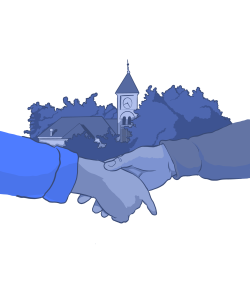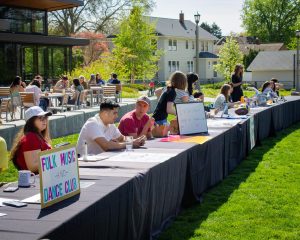On a silent Wednesday night in Penrose library junior Zach Morrissey popped open his laptop, picked out four pop songs from his music library and began arranging them as they all played simultaneously.
“You don’t sample to find a melody,” he said. “That’s easy. Anyone can come up with a good melody. You sample to get the original song.”
This type of combinative music, often called mash-up, has been significantly developed in recent years by artists such as Girl Talk. It involves blending two or more songs together to produce a seamless track. On one track, Morrissey overlaps the rapping vocals of Missy Elliot and Ludacris in “Ghetto Folks” to pumping beats from Daft Punk’s “Crescendolls.”
Morrissey explained that he often uses a technique of combining the vocals of one track with the melodies or beat of another.
“It’s so satisfying to find things that go well together,” he said. “Tempos, keys, music . . .”
Since coming to Whitman, Morrissey, under the name Ghetto Sunrise, has hosted a KWCW radio station, disc jockeyed at numerous parties and composed a full-length album of his mash-ups.
Morrissey began creating mash-ups at Whitman with junior Will Falltrick, who shares a mutual affection for electronic dance music.
“We were kind of bored with the DJs here,” said Morrissey, explaining that during his first year, he and Falltrick would listen to DJ duos like Justice and MSTRKRFT, bands that are popular in the world of electronic music but less familiar to mainstream music listeners.
On a whim, the two decided to form their own group.
“We thought, hey, these guys make great music. Why can’t we?” he explained.
Falltrick credited Morrissey’s motivation in starting the project.
“[Morrissey] wanted to do something a little more creative with the music. We were getting tired of hearing the same old rap songs at Whitman, which were fun,” said Falltrick. “But we [both] wanted something different.”
After Morrissey purchased an electronic MIDI mixer and acquired computer DJ software, the two began composing mash-up mixes in Morrissey’s room in Douglas Hall. Soon the bedroom DJs began airing their music through KWCW, at house parties and on an Internet blog.
Falltrick said that he and Morrissey would practice mixing songs before shows and then would perform live on the radio and at parties.
“[Radio shows] allowed us to sort of use a creative outlet for us to practice songs and try new things,” said Falltrick.
The electronic duo’s first gig was appropriately at Sigma Chi’s annual all-campus rave during the fall rush of 2008. Shortly thereafter, Ghetto Sunrise began DJing regularly at Whitman fraternity and house parties. Both Morrissey and Falltrick talked about the excitement and pleasure of DJing for Whitman crowds.
“People just went nuts,” Morrissey said grinningly, mentioning one night at the Ultimate Frisbee house, his favorite past event so far. “The whole room had their shirts off,” he said.
Eventually Ghetto Sunrise transitioned into a solo-act. With his partner Falltrick set to study abroad, Morrissey began recording his own mash-up tracks and continued playing live shows at Whitman.
Senior Graham Toben, another DJ on campus, often performs at Whitman in a line-up with Morrissey. Since the start of this school year, Toben and junior Chris Barton have DJed five events.
“The Whitman party scene usually revolves around two types of music: Hip hop and top 40, or dance,” said Toben in an e-mail. “So [Morrissey]’s music, by comparison, is a little unconventional. But people still enjoy it immensely. With the right crowd, there’s no DJ on campus that can match the energy that he brings to the stage and to his music.”
“What sets [Morrissey] apart from other DJs on campus is his relentless preparation before each show and execution during; he has to individually cue and loop each song and beat beforehand, then execute each transition perfectly while simultaneously pacing the show,” explained Toben. “He will usually be playing four songs at the same time, timing each one so as to develop a perfect buildup to the mash-up.”
In addition to hosting a weekly radio show and posting recordings of his performance on his blog (ghettosunrise.blogspot.com), Morrissey released his first mash-up album, Rise and Shine: The Mixtape, during the spring of 2009. After posting it on his blog for free, he relied on word of mouth through fellow classmates and friends at other colleges.
“It was totally sweet!” exclaimed Morrissey, mentioning that the album received 3,000 downloads.
Morrissey explained how, to his surprise, several months after the release, he received Facebook messages, e-mails and requests from friends to make another album.
As might be expected, Morrissey continued to DJ at Whitman parties and decided to work on new mash-ups. His first album contained 176 samples from a vast number of genres, including old school hip-hop, rap, pop, rock and electronic songs from popular artists. He said that his next album, Mixtape 2, will incorporate more than 300 samples and should release this spring. Registered under a U.S. Creative Commons License, Morrissey enjoys rights to legally share, reuse, and remix these tracks.
When asked about future plans for Ghetto Sunrise, Morrissey preferred to talk about the present.
“It’s really satisfying. I would still call it a hobby. But I wouldn’t put it past Whitman,” he said, explaining how he does not plan to work at clubs or DJ professionally after college.
“I’m just here to ride the wave,” said Morrissey. “I’m not in it for the lifestyle. I just do it to have fun.”
For more information on Ghetto Sunrise or to access free downloads to the music, go to Morrissey’s blog, ghettosunrise.blogspot.com.










